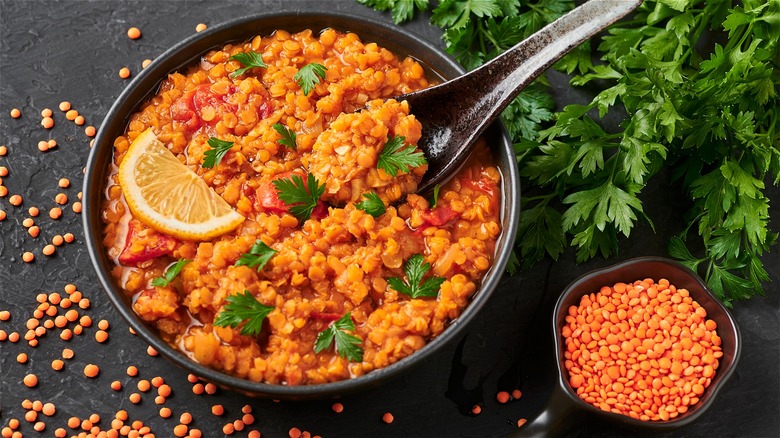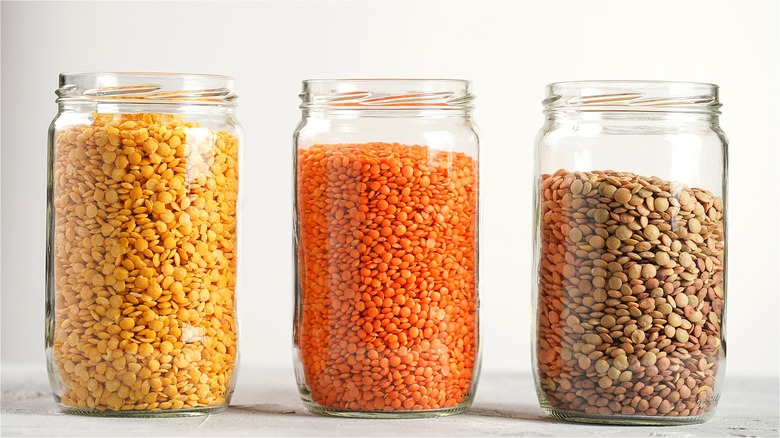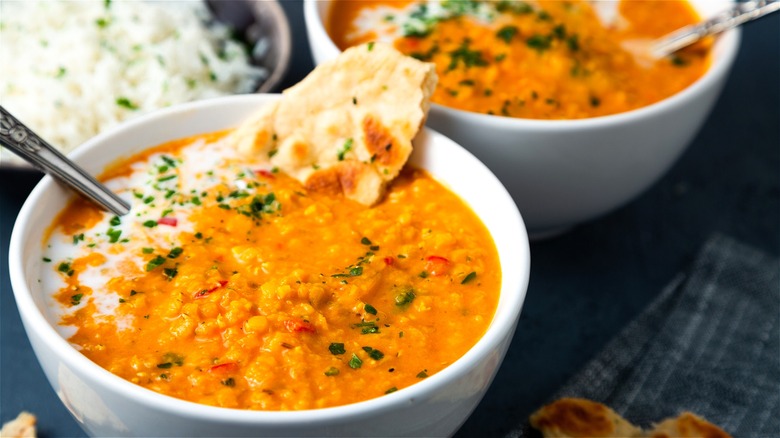Why Red Lentils Cook Faster Than Other Varieties
Nothing satisfies a growling stomach quite like a hearty bowl of easy lentil soup. Yet, depending on how much time you have to craft this tasty cold-weather meal, you may want to use a lentil variety that takes less time to cook. Among the most common varieties of dried legumes available, brown and green lentils are often sold whole, retain their shape for many diverse recipes, and range in flavor from earthy and mild to distinct and pepper-infused. On the other hand, red lentils (which can take on yellow or orange hues) are slightly smaller in size, have a sweeter flavor with a nutty taste and can be purchased whole or split, which impacts their overall cooking time.
Lentils provide our bodies with significant stores of protein, fiber, and essential vitamins and minerals such as thiamin, folate, and iron. Even though you can get a notable dose of nutrition from all lentils, if you need a fast cooking option, look no further than split red lentils. Split lentils have their outer skin (husks) removed, making them easier to break down over heat. Moreover, since split lentils are essentially cut into two halves, they cook much faster than their whole counterparts. If you need a quick option for an easy weeknight meal, split red lentils cook in less time and result in a creamy, satisfying consistency.
Choose red lentils for a shorter cooking time and a creamier base for all your favorite meals
If you're looking to make a meatless sloppy joe's alternative for tonight's dinner, when grabbing a bag of red lentils, reach for the split variety for a speedier cooking time. Lucky for you, split red lentils only take up to seven minutes to cook. For comparison purposes, whole red lentils take up to 20 minutes to soften, while their brown and green counterparts take 30 and 45 minutes to cook down. In less than half the time, split red lentils are ready to enjoy on their own or mixed into additional ingredients to create one delicious dish.
However, keep in mind that the most common varieties of red lentils available at your nearest grocery store are whole and split red lentils with the skins removed. Since both varieties have been somewhat processed, when cooked, they tend to break down fast, taking on a softer, creamier consistency. To better control the resulting texture, cook red lentils over the stove. Once lentils have reached your desired texture, drain any excess water and enjoy. Yet, if you want to lean into the steadily soft consistency of cooked red lentils, there are plenty of delicious dishes worth trying.
Use red lentils to make a variety of quick and tasty recipes
Cooked red lentils don't typically hold their form too well as a topping for salads or other fresh dishes. Therefore, cooking these varieties down into your favorite cold-weather meal is most common. Since both whole and split red lentils break down naturally throughout the cooking process, you can make a delicious lentil soup over your stove or throw all the suggested ingredients into one appliance to make a slow-cooker red lentil soup. The lentils will naturally break down over five to seven hours. If you want an extra creamy dish, use your immersion blender to give your soup a thicker consistency. You can also make a variety of culturally rich dishes, such as Indian curry or dal, which is a popular dish made of cooked legumes, onions, and various spices. This chunky mash or stew is often consumed with fresh herbs, rice, and chapati bread.
While turning red lentils into puréed mash leads to many tasty soup and rice dishes, you can also use these colorful legumes to make ultra-satisfying appetizers like red lentil and peanut dip. For a tasty hummus alternative, swap out your standard can of chickpeas for cooked red lentils. Since both whole and split lentils that have been hulled cook down faster than other varieties, you can use these tiny red legumes to make many convenient yet flavorful dishes.


